Original publication by Tim Root for washingtonpost.com on 20 August 2021
A province first pledged to plant 1 billion trees in 2015. The initiative was so successful
that the country is now in the midst of a ‘Ten Billion Tree Tsunami’ to fight climate change.

(Sarah Caron)
August marks the beginning of monsoon season in Pakistan, and with the rain comes another busy stretch for the country’s ambitious tree-planting program.
In Khyber Pakhtunkhwa province, residents of all stripes, from government officials to Boy Scouts, fan out along the hills. They bring with them chinar tree saplings — which can grow to nearly 100 feet tall — along with other varieties, and they begin digging.
It’s all part of an effort that started in 2015, when Imran Khan — then a provincial politician and now Pakistan’s prime minister — backed a program dubbed a “Billion Tree Tsunami.” The initiative reached its provincewide target in 2018 and was so successful that federal officials expanded the drive nationally in 2019 with a new goal of 10 billion trees — or, the “Ten Billion Tree Tsunami.”
“Everyone is waking up and starting to plant,” lawyer and environmentalist Hazrat Maaz told The Washington Post at the time.
The program addresses Pakistan’s history of deforestation as the country confronts the realities of climate change in the form of hotter temperatures, melting Himalayan glaciers and intensifying monsoon rains.
“It makes us very vulnerable,” Malik Amin Aslam, Pakistan’s federal minister for climate change, said in a recent phone call. He has overseen both the provincial and national planting campaigns. “The cheapest, most effective and quickest way to fight climate change is to plant trees,” he said.
Direct planting, Aslam explained, accounts for about 40 percent of the program’s new trees. Hundreds of thousands of people across Pakistan are working to nurture and plant 21 species, from the chir pine to the deodar — the national tree.
The other 60 percent come from assisted regeneration, in which community members are paid to protect existing forests so that trees can propagate and thrive. Protectors are known as “nighabaan,” and 11 individuals lost their lives fighting the “timber mafia” between 2016 and 2018, according to Aslam.

(Sarah Caron for The Washington Post)
Whether planted or protected, trees capture and hold carbon dioxide — a greenhouse gas that contributes to climate change — and combat erosion on steep landscapes in Pakistan that Aslam says are “almost like living on a slide.”
The latest tree “tsunami” appears to be on pace. The rate of new trees has gone up tenfold since the initiative began, Aslam said. He expects another 500 million trees by the end of this year, with a goal of around 3.2 billion by 2023. If the current ruling party — Movement for Justice — is reelected, the aim is to hit 10 billion trees by 2028.
Aslam says the initiative is engaging the next generation in the country’s battle against climate change.
“Young people get very excited when they hear about this,” he said. “It’s their future that we’re investing in.”

(Sarah Caron for The Washington Post)

(Sarah Caron for The Washington Post)

(Sarah Caron)

(Sarah Caron)

(Sarah Caron)
“Young people get very excited when they hear about this. It’s their future that we’re investing in.”
– Malik Amin Aslam, Pakistan’s minister for climate change

(Sarah Caron)

(Sarah Caron)

(Sarah Caron)

(Sarah Caron for The Washington Post)




